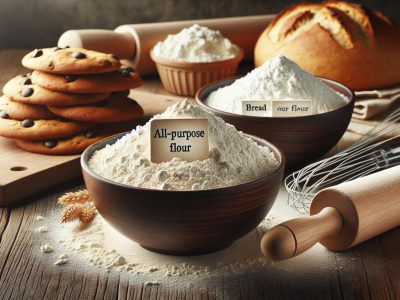Top 7 Alternatives to Self-Raising Flour for Perfect Baking Results
Baking can feel like a magical science, but what happens when you’re halfway through a recipe and realize you’re out of self-raising flour? Don’t let that moment of panic ruin your culinary adventure. The good news is, you don’t need to rush to the store—your pantry likely holds everything you need to whip up the perfect substitute.
Self-raising flour isn’t as irreplaceable as it seems. By understanding its simple components, you can create alternatives that not only save the day but also give you more control over your recipes. Whether you’re avoiding store-bought mixes or experimenting with new flavors, these substitutes can elevate your baking game while keeping things stress-free.
What Is Self-Raising Flour?
Self-raising flour combines all-purpose flour, baking powder, and salt. Its pre-mixed nature simplifies baking by eliminating the need to measure leavening agents separately. Popular in quick bread, biscuits, and cakes, it ensures an even rise in recipes where an additional leavening boost is necessary.
This flour typically contains 1-1.5 teaspoons of baking powder and around 0.5 teaspoons of salt per cup of flour. Brands may vary slightly in composition, which can impact recipe outcomes. Always review packaging labels to understand ingredient proportions.
You find self-raising flour used in recipes requiring minimal mixing. Over-mixing can activate its baking powder prematurely, affecting texture. Knowing when to use this flour versus plain flour helps maintain control over your final bake.
Why Look For An Alternative To Self-Raising Flour?
Exploring alternatives to self-raising flour offers flexibility in baking. If you don’t have it on hand when baking, substitutions ensure your recipe doesn’t go unfinished. Understanding replacements, like blending all-purpose flour with baking powder and salt, can expand your skills, making you less reliant on pre-mixed products.
Dietary restrictions or preferences may lead you to explore other options. Gluten-free flours or specialty mixtures, for example, cater to specific needs, enabling everyone to enjoy baked goods without compromise. Also, some recipes may require better control over the ratio of leavening agents, which a self-created blend allows.
Avoiding processed blends is a common reason for choosing alternatives. Self-raising flour often contains additives or preservatives found unwanted by those seeking organic or wholesome ingredients. Substituting lets you choose each component, ensuring high-quality and transparency in what your family consumes.
Common Substitutes For Self-Raising Flour
Running out of self-raising flour doesn’t mean you need to put your baking on hold. Different substitutes produce great results, letting you adapt recipes to suit your pantry or dietary needs.
All-Purpose Flour With Baking Powder
Mixing baking powder with all-purpose flour creates a functional self-raising flour substitute. Use 1 cup of all-purpose flour combined with 1.5 teaspoons of baking powder and 0.25 teaspoons of salt. This blend mimics pre-mixed self-raising flour, ensuring your cakes and breads rise evenly. For example, if you’re baking biscuits, this substitution maintains a fluffy texture without altering the flavor.
All-Purpose Flour With Baking Soda And Acid
You can create a self-raising effect using baking soda and an acidic ingredient like vinegar or yogurt. Combine 1 cup of all-purpose flour with 0.5 teaspoons of baking soda and an acid equivalent to 1 teaspoon of vinegar or lemon juice. This combination works well in recipes where liquid consistency won’t affect the result, such as muffins or pancakes. Adjust liquid quantities in your recipe to avoid overly wet batter.
Gluten-Free Flour Blends
Gluten-free flour blends paired with suitable leavening agents offer a versatile substitute for dietary restrictions. These blends typically include rice flour, potato starch, and tapioca flour. Pair 1 cup of gluten-free flour with 1.5 teaspoons of baking powder and 0.25 teaspoons of salt. Ensure the blend contains xanthan gum or a similar binding agent for structure. For example, this adapts recipes like banana bread for gluten-free needs without sacrificing flavor or texture.
Whole Wheat Flour Alternatives
Using whole wheat flour changes texture and flavor but works as a healthy alternative. Mix 1 cup of whole wheat flour with 1.5 teaspoons of baking powder and a pinch of salt. Whole wheat improves fiber content, making it ideal for hearty recipes like scones or savory quick breads. Remember, whole wheat absorbs more liquid, so consider adjusting liquid proportions to maintain balance in your batter.
How To Use Homemade Flour Alternatives In Recipes
Homemade flour substitutes allow you to maintain control over your baking results. By understanding ingredient proportions and their effects, you can confidently experiment with various recipes.
Adjusting Ratios For Different Recipes
Baking demands precise ratios, especially when replacing self-raising flour. Combine 1 cup of all-purpose flour with 1-1.5 teaspoons of baking powder and 0.5 teaspoons of salt. Adjust the baking powder quantity for cakes or dense baked goods, reducing it slightly for softer textures.
Recipes like biscuits or scones perform better with minimal variations, as too much leavening creates a metallic aftertaste. Conversely, quick breads tolerate slight ratio deviations without sacrificing structure. Integrate adjustments when using gluten-free blends or whole wheat flour since these alter liquid absorption and texture.
Tips For Achieving Desired Texture And Flavor
Texture and flavor depend on ingredient balance. Substitute whole wheat flour for up to half the all-purpose flour to add nuttiness but prevent dense results in lighter recipes like cupcakes. If using gluten-free blends, add binders like xanthan gum to stabilize the crumb in cookies or cakes.
Salt impacts flavor—a pinch more or less changes taste perception. For instance, sweet muffins benefit from slight boosts in salt, while overly salty batters can overshadow subtle vanilla or fruit flavors. Test small batches when altering substitutes to refine your ideal texture and taste.
Best Situations To Use Self-Raising Flour Alternatives
Self-raising flour alternatives work best when flexibility or dietary adjustments are needed. Certain recipes like pancakes, muffins, or quick breads benefit from these substitutes because precise ratios of leavening agents ensure consistent results. For example, combining all-purpose flour with baking powder and salt provides the same texture as self-raising flour, maintaining the rise and fluffiness in these recipes.
Homemade blends offer greater control for recipes that require customization, such as gluten-free cakes or pastries. You can use almond flour with a leavening agent in desserts or coconut flour with added eggs to provide structure in gluten-free baking. These options work well in recipes focused on specific dietary needs.
Occasions when you’re out of self-raising flour but have pantry staples such as baking powder and salt also make these alternatives convenient. Adjusting proportions allows you to bake without interruptions while replicating the original recipe’s characteristics. For instance, if cake batter feels dense, increasing the baking powder slightly ensures an even rise.
Baking experiments become easier with these substitutes, especially if you enjoy altering traditional recipes. Replacing self-raising flour with whole wheat flour makes baked goods more nutritious. Adding cinnamon or nutmeg to these substitutes could even enhance the flavor profiles of breads or muffins.
Avoid using alternatives in yeast-based recipes like pizza dough or sourdough bread since they rely on fermentation, not chemical leavening, for rise. In these cases, self-raising flour or its substitutes would disrupt the process, leading to imbalanced textures.
Using substitutes demands careful measurement. Overestimating or underestimating baking powder may affect the finished texture. For example, too much leavening can cause cakes to rise quickly but collapse later, while too little results in dense outcomes. Always balance the quantities based on the recipe’s requirements for optimal results.
Conclusion
Running out of self-raising flour doesn’t have to disrupt your baking plans. By understanding its components and experimenting with simple substitutes, you can maintain control over your recipes and even elevate your baking skills. These alternatives offer flexibility, cater to dietary needs, and allow for more personalized creations in the kitchen.
With just a few pantry staples, you can confidently replace self-raising flour and ensure your baked goods turn out just as delicious. Precise measurements and thoughtful adjustments are all it takes to keep your baking seamless and stress-free.
- King vs Queen Size Bed: An In-Depth Comparison for Your Perfect Mattress Choice - October 29, 2025
- Krill Oil vs Fish Oil: Key Differences, Benefits, and Choosing the Right Omega-3 Source - October 29, 2025
- Understanding the Difference Between OT and PT: A Comprehensive Guide - October 29, 2025







